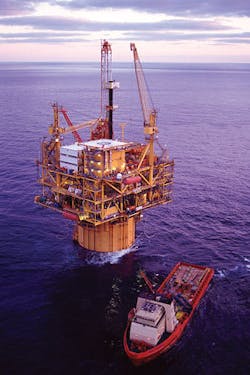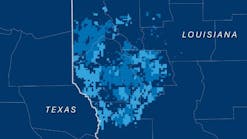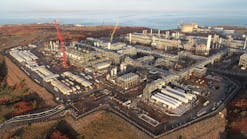Gulf of Mexico world’s hottest play, but challenges still loom
The US Gulf of Mexico is the world’s hottest exploration and development play and the most important source of US oil and natural gas supply.
Both superlatives are likely to be reaffirmed in the years to come. Factors in that outlook include recent tests confirming the producibility of giant reservoirs in the Lower Tertiary trend in the gulf’s deep water, the extension of royalty incentives for deepwater and deep-pay production, and the growing importance of the underexplored deep-shelf gas play.
The resource target is huge, according to Chris Oynes, regional director, Gulf of Mexico region, US Minerals Management Service.
“The 2006 resource estimate issued by MMS estimates that there is a mean esimate of 86.3 billion bbl of oil equivalent remaining to be discovered in the gulf-about 44.9 billion bbl of oil and 232.5 tcf of gas,” he says.
Couple that impressive potential with the diminished access to giant-scale prospects elsewhere in the US and the gulf’s low political risk, and the resulting outlook is bright.
“The Gulf of Mexico-and more specifically the deepwater Gulf of Mexico-is not only important to current US oil and gas supply, it is critical to future US oil and gas supplies,” says Jean P. Cahuzac, executive vice-president and chief operating officer of Transocean Inc., Houston. “Yet-to-find (YTF) estimates in the range of 23 billion bbl of oil and 80 tcf of gas…make the deepwater Gulf of Mexico by far the largest YTF estimate in the US.
“Additionally, deepwater Gulf of Mexico fields compete very favorably with oil producing provinces around the world, owing to the high rate of geologic success and relatively more favorable royalty and fiscal regime.”
Devil’s Tower truss spar in the ultradeepwater Gulf of Mexico has capacity for 60,000 b/d of oil and 110 MMcfd of natural gas. Photo courtesy of Dominion Exploration & Production.
The gulf is one of the few remaining areas in North America with vast resource potential, notes Steve Hadden, senior vice-president, exploration and production, Devon Energy Corp., Oklahoma City: “The gulf produces 2.2 million boe/d-25% of US production.”
Devon is a key player in the suddenly sizzling Lower Tertiary trend, which netted widespread headlines with the recent announcement of the first successful extended well test of the play-one that could hold 9-15 billion boe of potential reserves. Hadden says that Devon’s currently identified Lower Tertiary prospects could be as much as 300-500 MMboe each.
“Since access to hydrocarbon-bearing regions in the United States is limited, it is a significant accomplishment that the industry is able to use technology to tap into an area with this amount of resource potential,” he adds.
A ‘technology’ play
The Lower Tertiary play is a prime example of why Gulf of Mexico E&D today is driven by technology rather than traditional geology approaches.
Much of the Lower Tertiary trend lies in ultradeep-5,000-10,000 ft-waters and at great depths below the seabed. And the structures in question are elusive to conventional seismic imaging, obscured by vast salt canopies. Until very recently, the industry consensus was against the notion that Lower Tertiary sands would be present or producible at such great depths.
“Today, seismic imaging is more advanced, allowing us to see past salt canopies and get much clearer images of formations as deep as 30,000 ft or more,” Hadden notes. “Additionally, fifth-generation drilling vessels have made it possible to penetrate 10,000 ft of water to a total depth of 35,000 ft, overcoming the drilling challenges of just a few years ago.”
Advances in technology and materials enabling the drilling of high-temperature/high-pressure wells in corrosive environments are helping to unlock the huge gas potential of the deep shelf in shallow gulf waters. MMS has estimated deep-shelf gas potential at as much as 20 tcf.
Of course, robust drilling activity in the Gulf of Mexico also is driven by expectations of continued high oil and gas prices as well.
“In my view, the Gulf of Mexico will continue playing a very significant role in US oil and gas supply,” says Renaldo Bertani, vice-president, Petrobras America Inc. “And the reason is simple: New technology and the new market reality are making it feasible and attractive to continue exploring and developing reserves that were beyond reach just a few years ago.”
While the technology challenges for expanding the deepwater and deep-shelf plays are substantial, the biggest concerns for Gulf of Mexico operators and service/supply operators are nontechnical in nature: shortages of rigs and personnel, rising costs, leasing hurdles, and coping with natural disasters.
Rig availability
Drilling activity in the Gulf of Mexico could be constrained by the lack of available rigs worsening from today’s already tight market.
Despite strong demand, rig supply in the gulf has slumped in the past 5 years. Almost 150 rigs were available for work in the gulf in 2001. Today, there are about 90. The upturn in oil prices in recent years has pulled rigs from the gulf to other areas of the world, drawn by more lucrative day rates and longer-term contracts elsewhere.
In the short term (2006-08), says Cahuzac, “activity in the Gulf of Mexico will be constrained by the number of rigs available; this is at a time when there is an anomalously high turnover of leases, prompting a demand with a critical timing component.”
Bill Coates, president, Schlumberger north America, warns that “a chronic shortage of jack up rigs is about to develop, which will further depress shelf production for oil or gas.”
Personnel concerns
In both the short and medium term, the most critical issue is human capital, Cahuzac says.
“This will be an industry-wide problem but perhaps most challenging for the drilling contracting industry.
“The ultradeepwater fleet of rigs operating in the US Gulf of Mexico is projected to double in size by 2009. The industry will be challenged to recruit top talent, both fresh-out and midcareer hires, and accelerate their development to produce supervisors in a substantially shorter time than has ever been achieved before.”
Among other measures, Transocean is taking steps to deal with the shortage of qualified personnel in Gulf of Mexico operations through recruiting, accelerated development, and retention initiatives, says David Mullen, the company’s vice-president, North and South America:
- “Broadening the areas in which we recruit in an effort to enrich the talent pool of fresh-outs. We are expanding beyond the Gulf Coast states, which have been our main recruiting areas in the past.
- “Constantly looking at industries where we can achieve synergistic development. For example, we are targeting the aeronautical industry for subsea engineers.
- “Invested heavily in accelerated training programs, training tools, training schools, and dedicated mentors.
- “Management commitment to accelerated development. We monitor and reward supervisors and rigs for success in the program. Also, we continually remind everybody of the criticality of this function for the future success of the company.
- “Retention of our existing strong experience base is achieved through constantly monitoring compensation to ensure we have a competitive compensation package. In addition, management maintains visibility on the rigs to facilitate a healthy two-way communication.
- “Morale-building tools are utilized such as a well-understood career development process.”
Dealing with personnel concerns also is related to a key issue facing the industry, says Lew Mologne, president of oil and gas treating services company ProSep Technologies Inc., Houston-“that being the need to use much better partnering-based relationships to streamline projects and reduce time and costs.”
Regulatory issues
Access remains a key concern even in this busiest of offshore provinces-considering that almost a third of the gulf, the eastern portion, remains off-limits to leasing.
“Although a host of new technologies has opened the Gulf of Mexico to possible development development, government-imposed moratoriums are limiting the amount of exploration and production activity that can be completed in the area,” says Hadden.
Bertani is concerned about the duration of shallow-water leases in which ultradeep reservoirs are being explored and developed: “The new technological developments that will be required to explore for and bring on stream such extremely deep reservoirs will take some time to develop, and the current lease terms may not be sufficiently long.”
In addition to easing access to exploration acreage in the eastern gulf, Cahuzac favors more flexibility on revenue sharing with the Gulf Coast states on deepwater royalties and lease payments.
Another regulatory snafu, adds Cahuzac, is that “limited flexibility in using non-US nationals for offshore work on MODUs [mobile offshore drilling units] makes it very difficult to bring a unit into US coastal waters for a short-duration period.”
Coates worries about “the tension between state and federal governments and the change to royalty regimes.
“We cannot afford any delay in the large-scale deepwater development of oil and gas.”
Disaster planning
Gulf of Mexico players learned some grim lessons about disaster planning in the wake of 2005’s devastating Hurricanes Katrina and Rita, which destroyed more than 100 gulf platforms, set 19 MODUs adrift, and shut in 92% of the gulf’s oil production and 83% of its gas output.
Gulf operators and service/supply companies have formed a joint industry project on mooring systems to advise the industry on risk-mitigating factors and provide input for impending new regulations.
Mullen cites the following steps Transocean has taken in its disaster-planning iniative:
- Improving stationkeeping capacity of moored deepwater semisubmersibles.
- Conducting site-specific assessments for each location during storm season to assess the potential consequences of mooring failure.
- Continually updating and modifying tropical storm evacuation plans to minimize risk to people on both dynamically positioned and moored units.
Importing technology is one approach Petrobras, with its extensive deepwater experience off Brazil, is taking, says Bertani:
“We are bringing the expertise that we developed offshore Brazil, particularly with the utilization of FPSOs [floating production, storage, and offloading units], customized to the Gulf of Mexico conditions.
“We are planning to deploy an FPSO with a disconnectable turret in our operated developments of Cascade and Chinook [ultradeepwater fields]. This will allow quick disconnection in case of imminent hurricanes so that the vessel can move away from the storm and reconnect once the sea conditions allow.”


